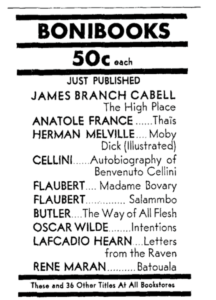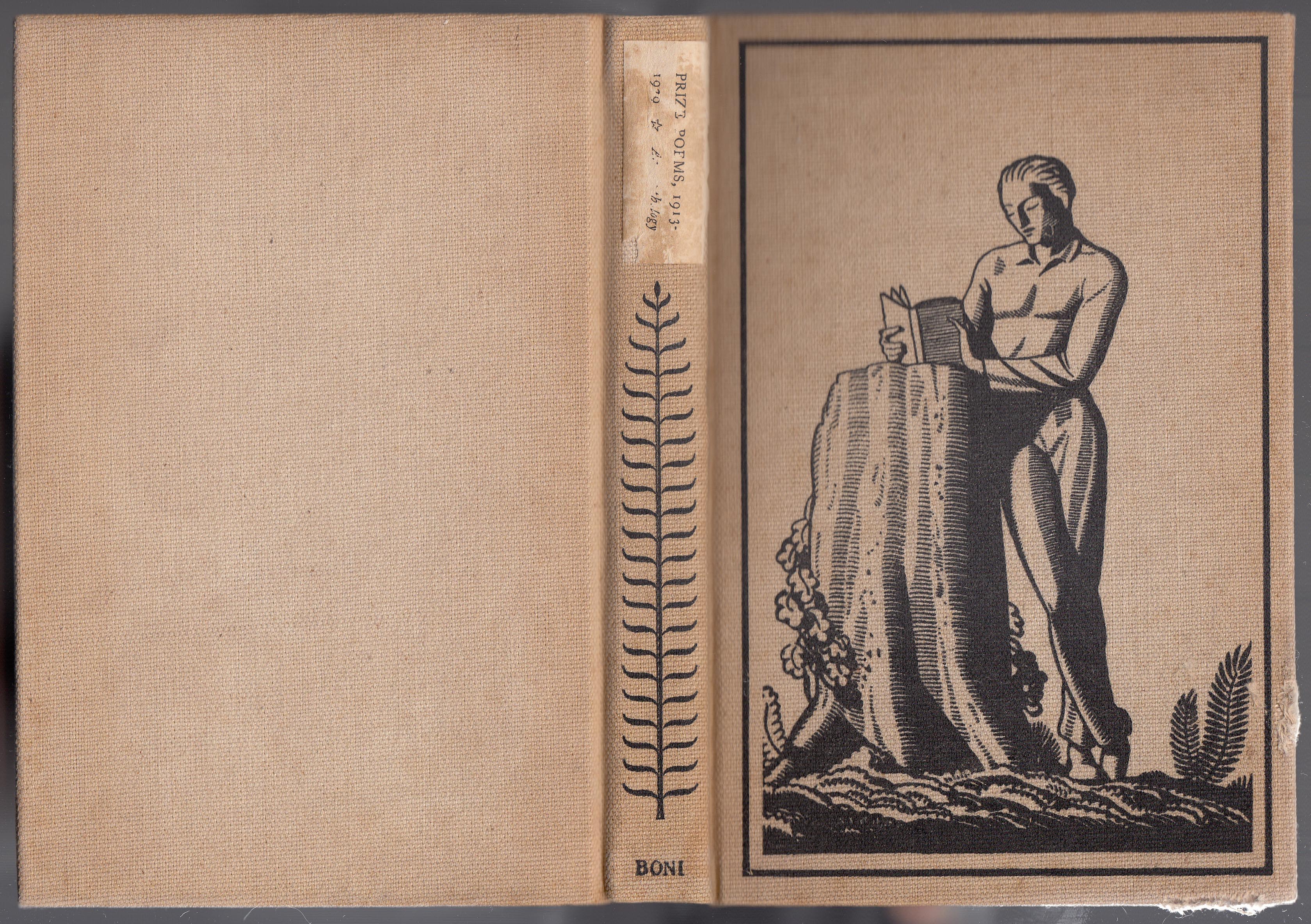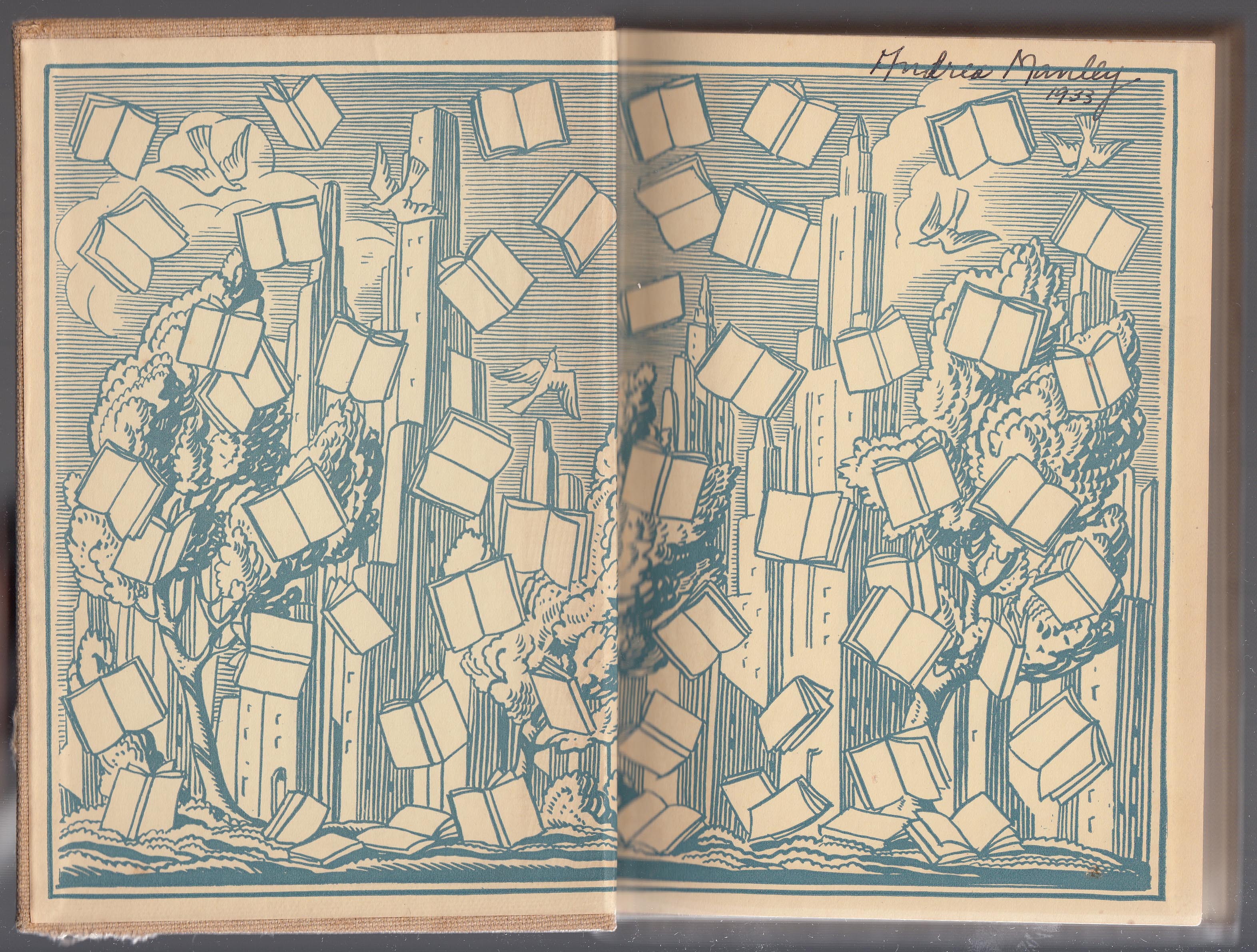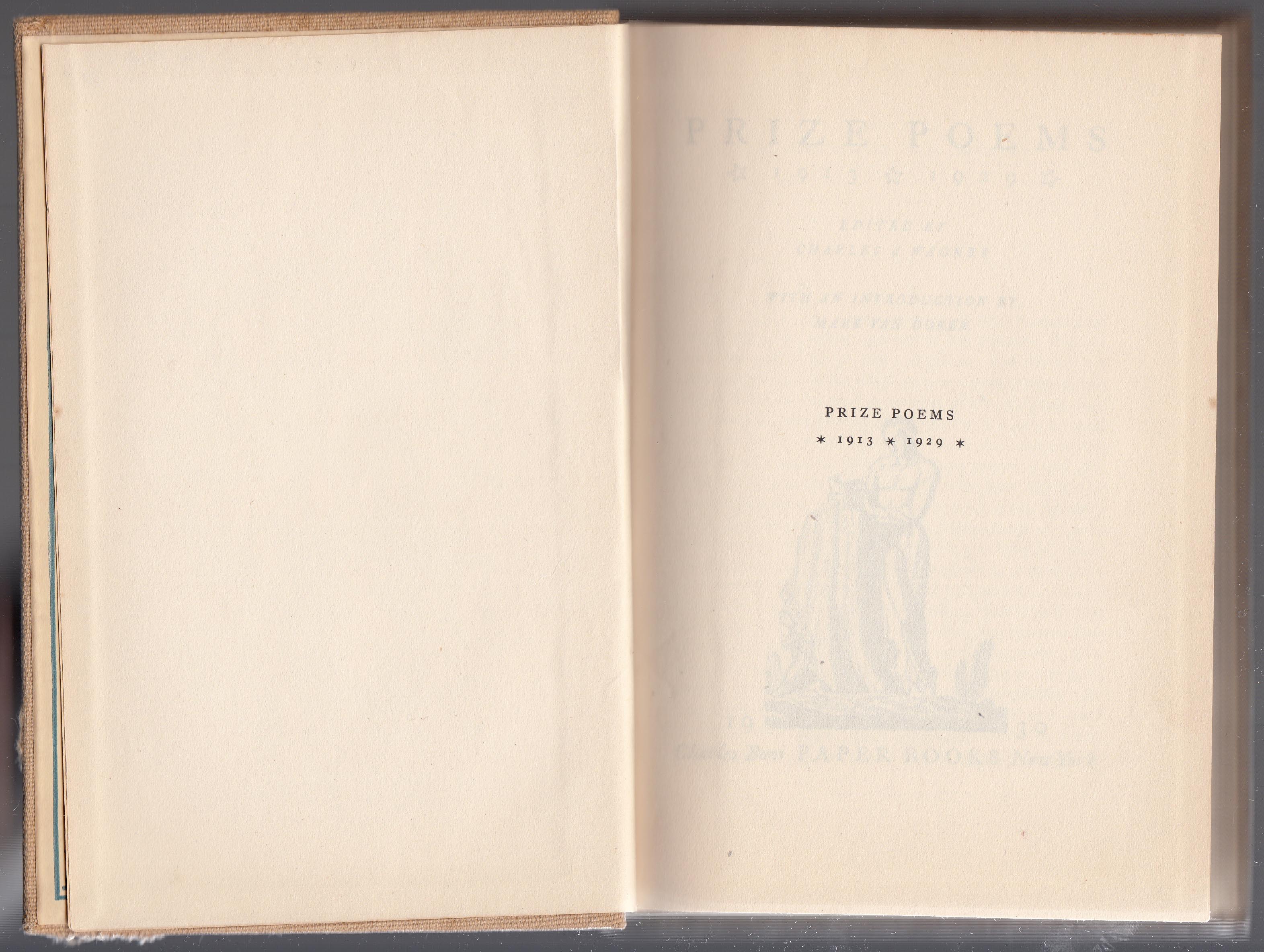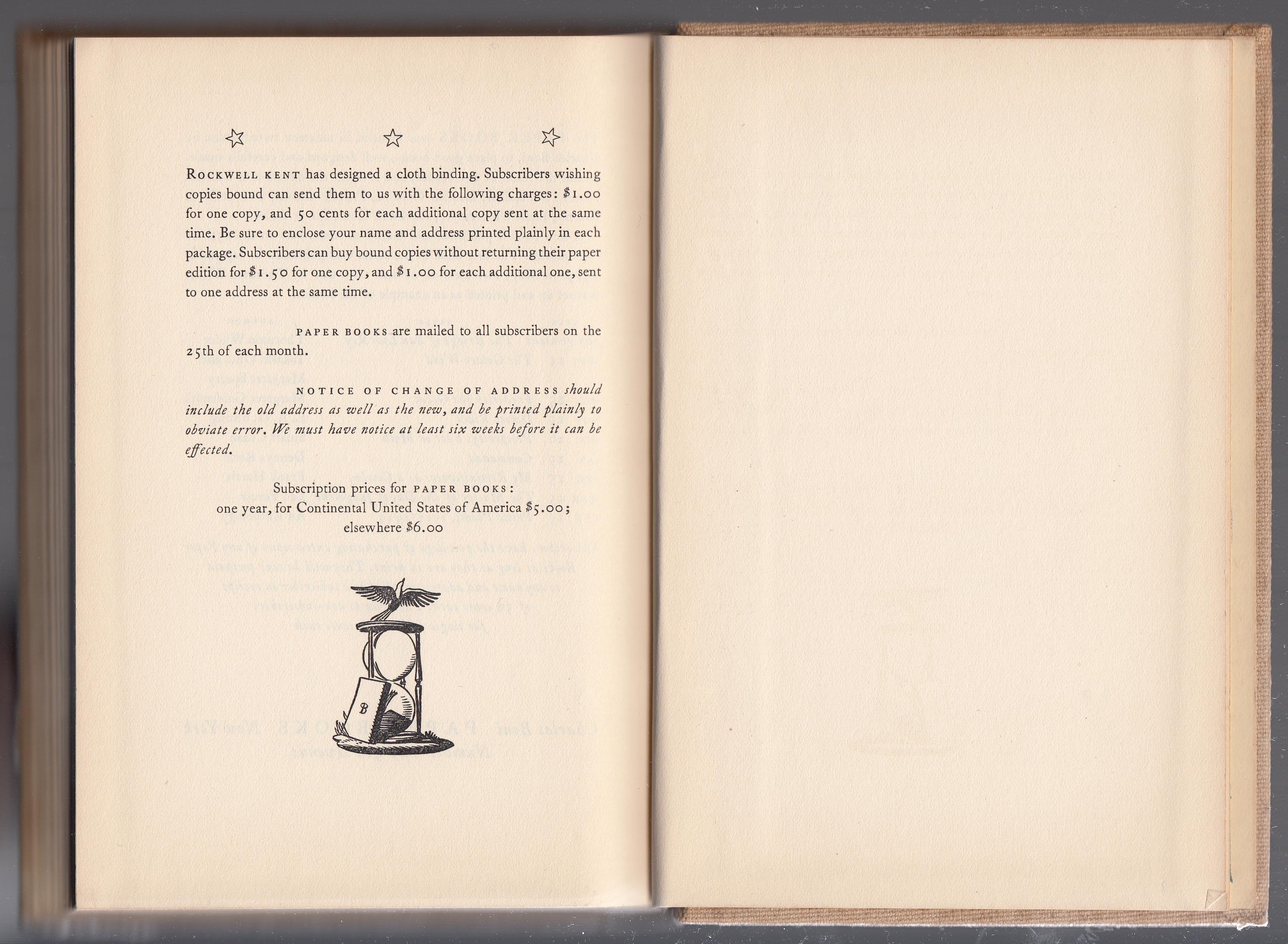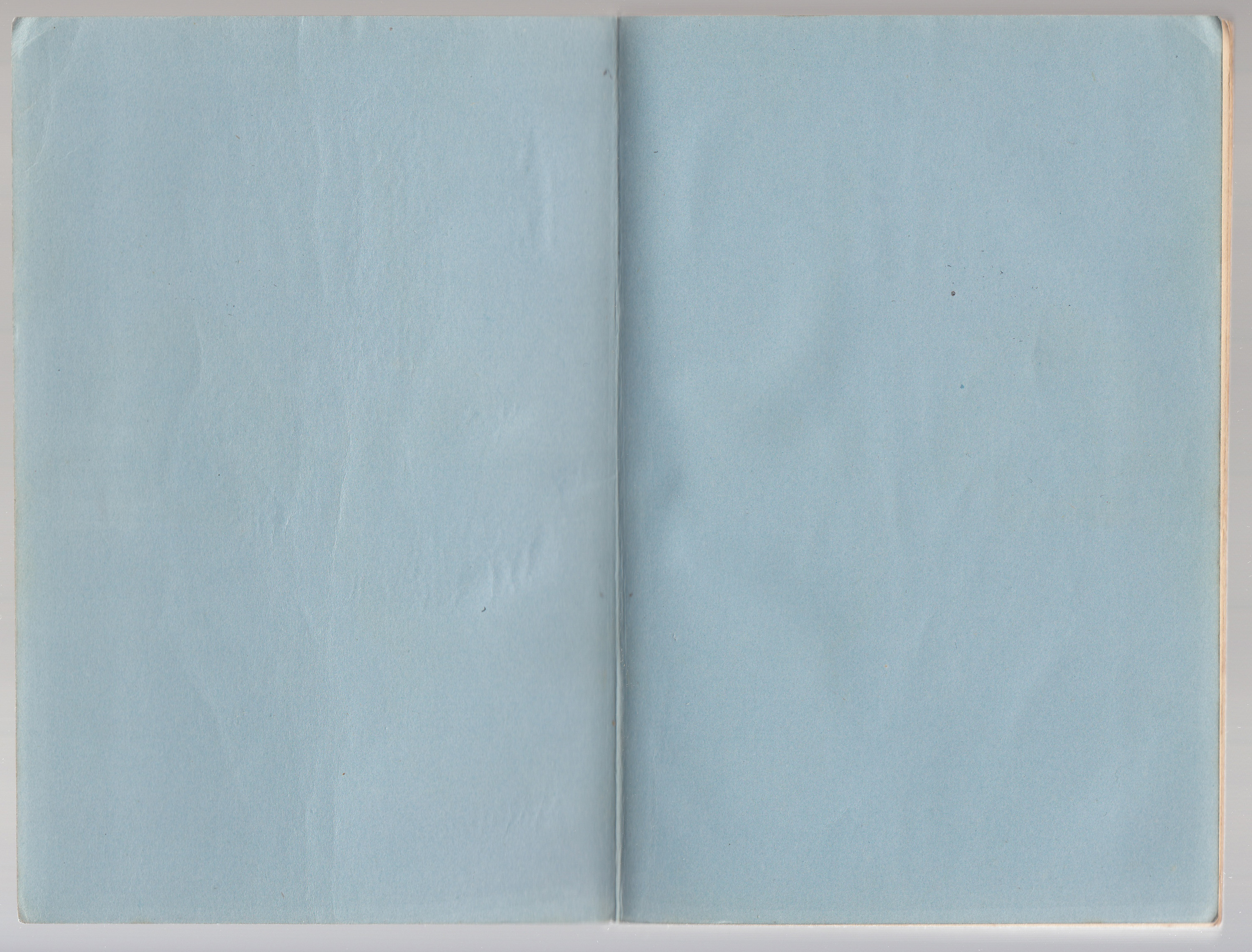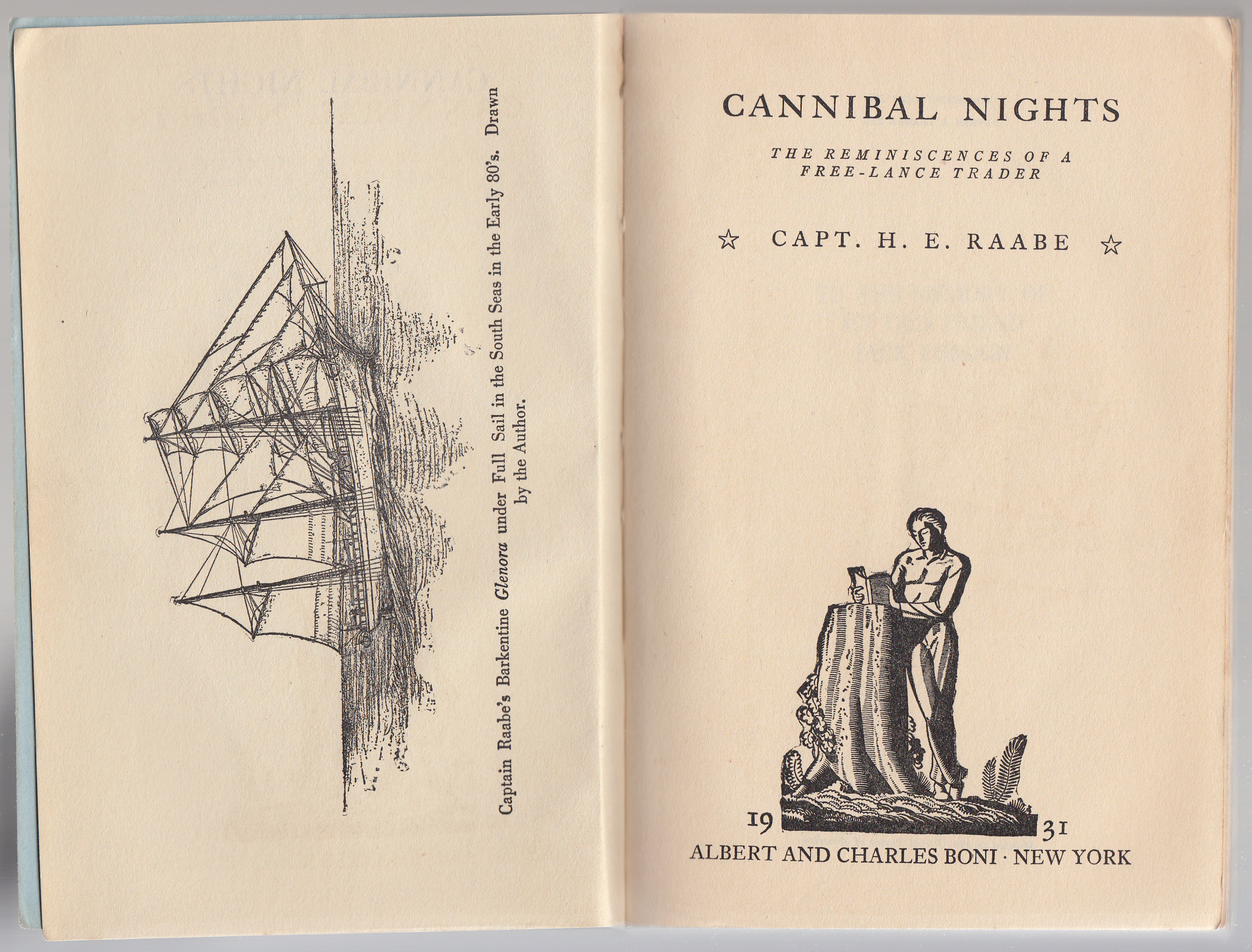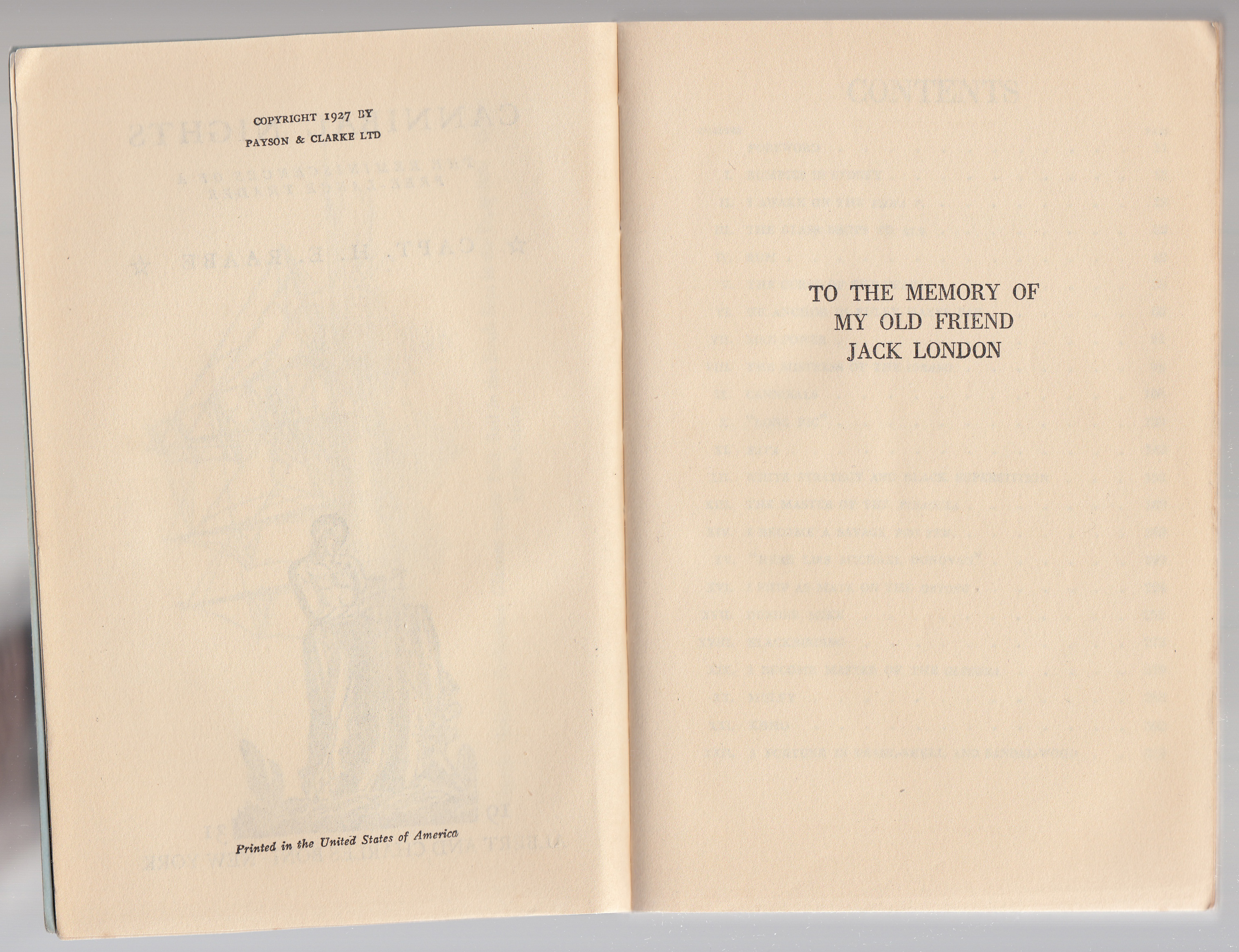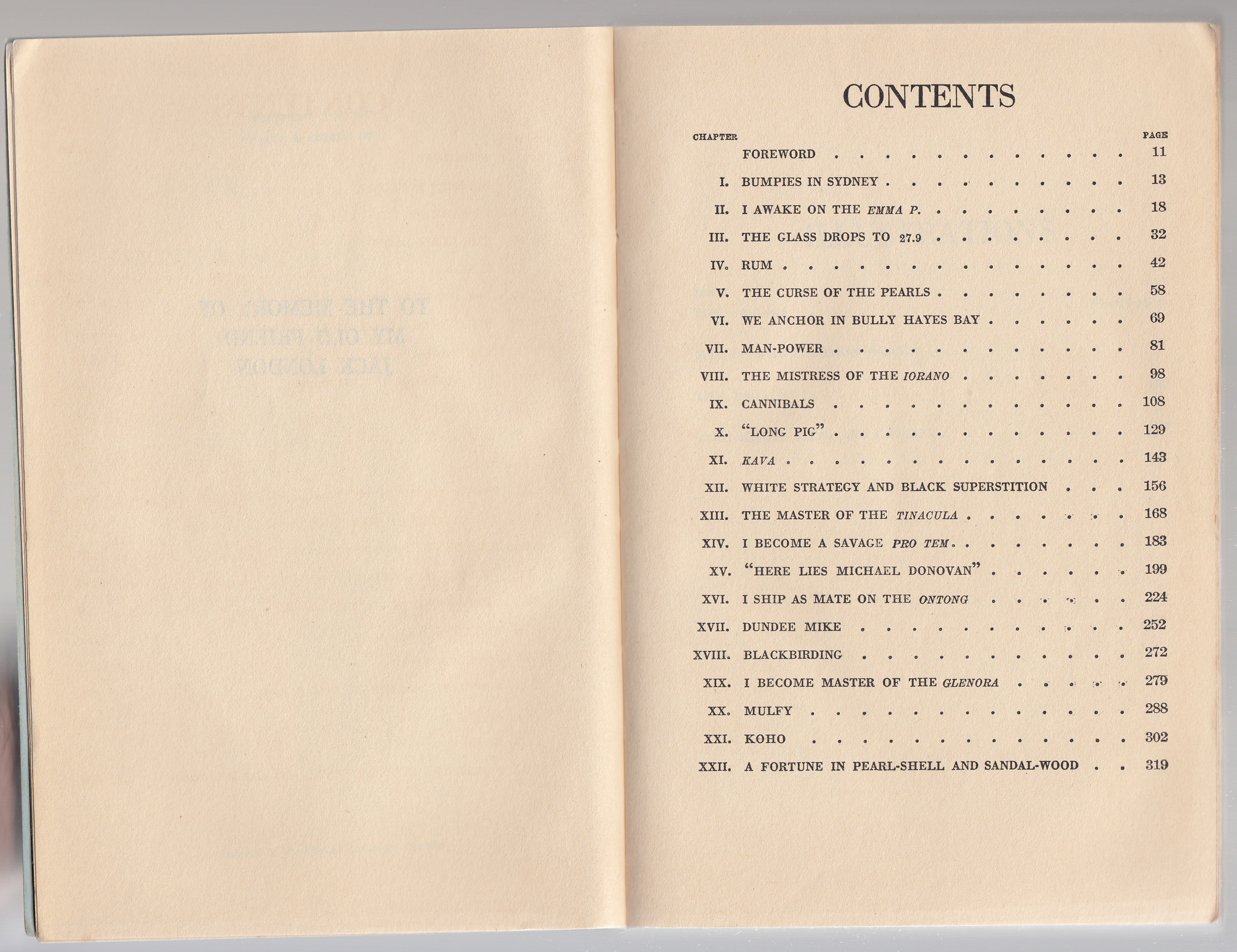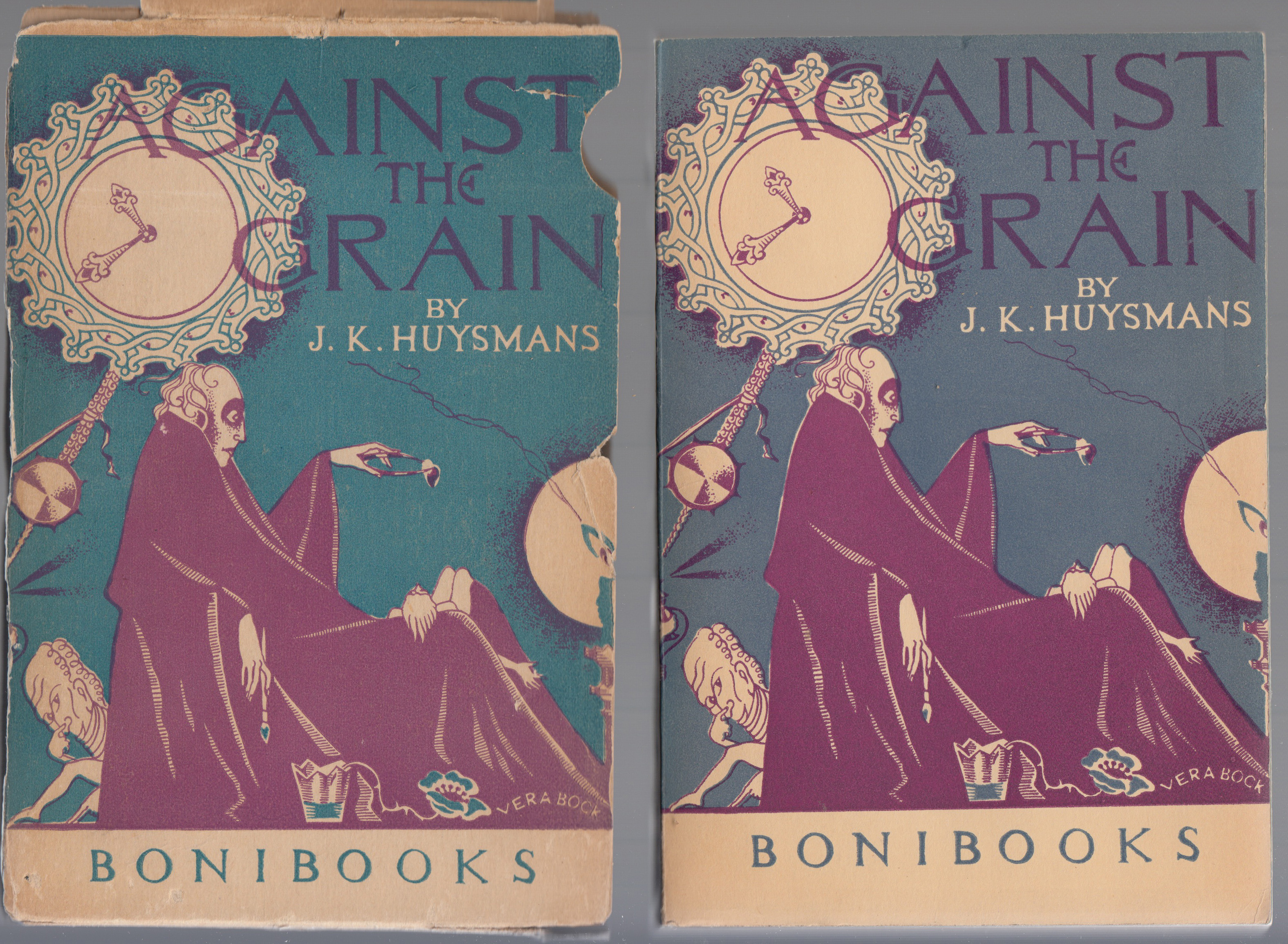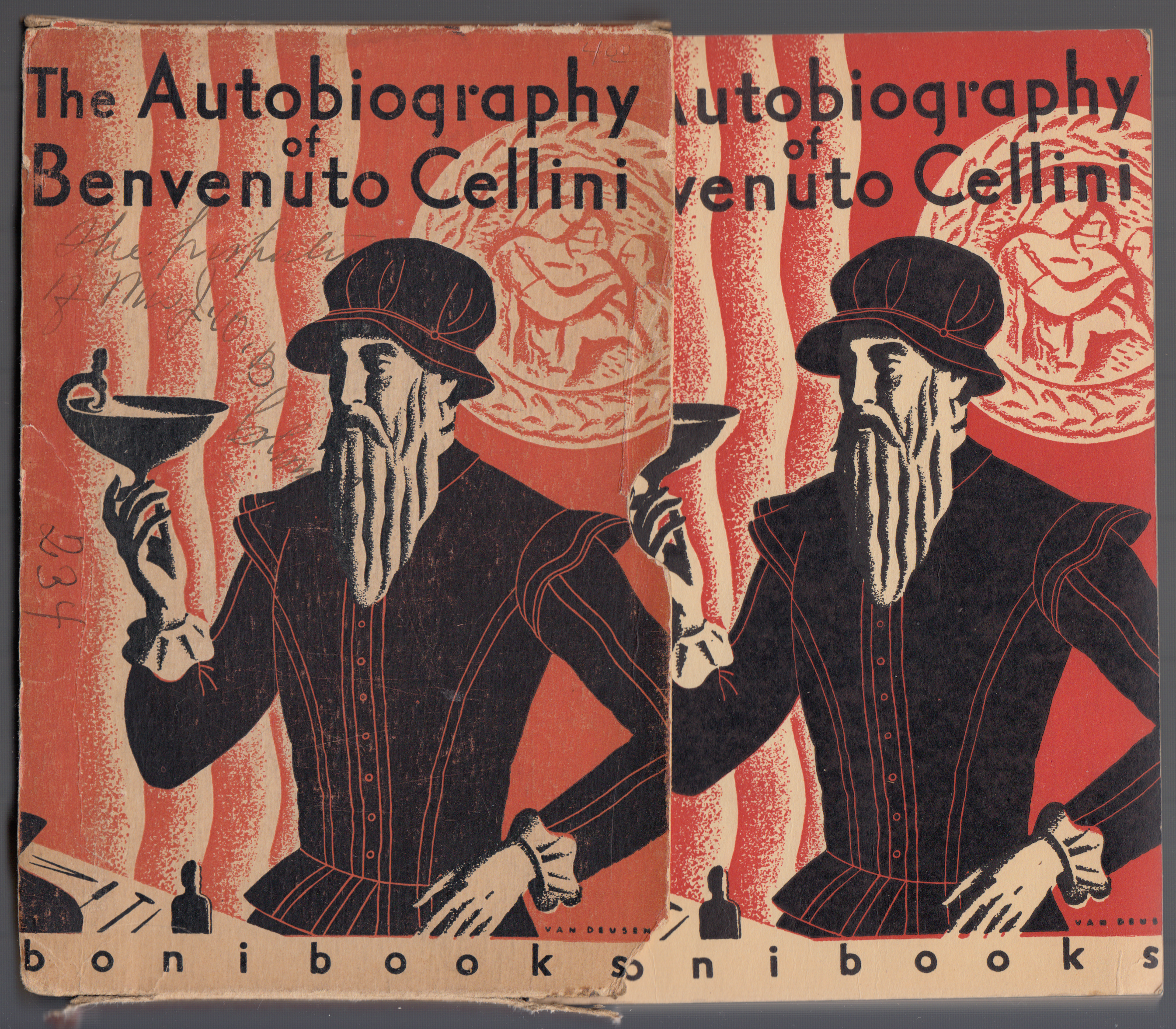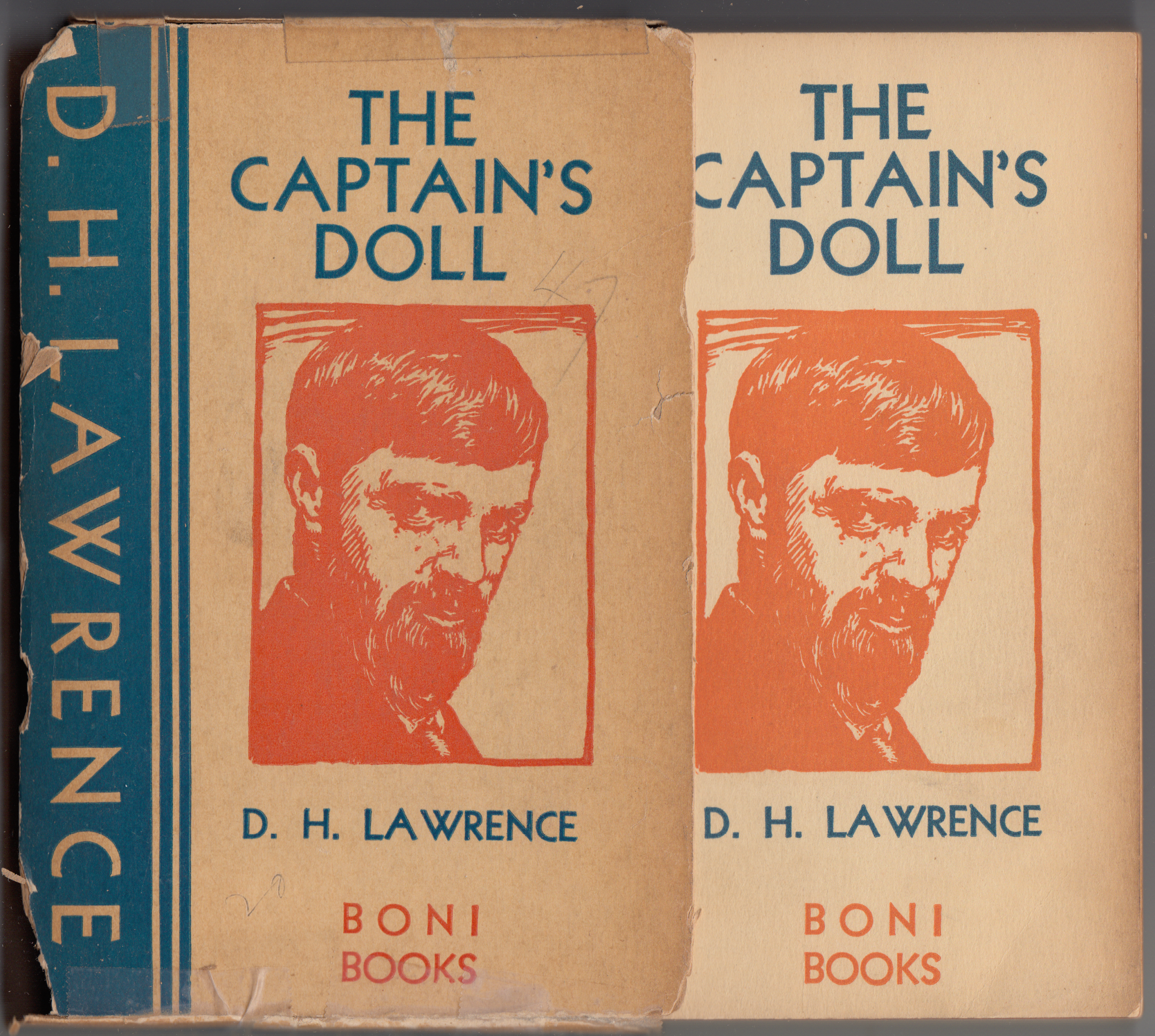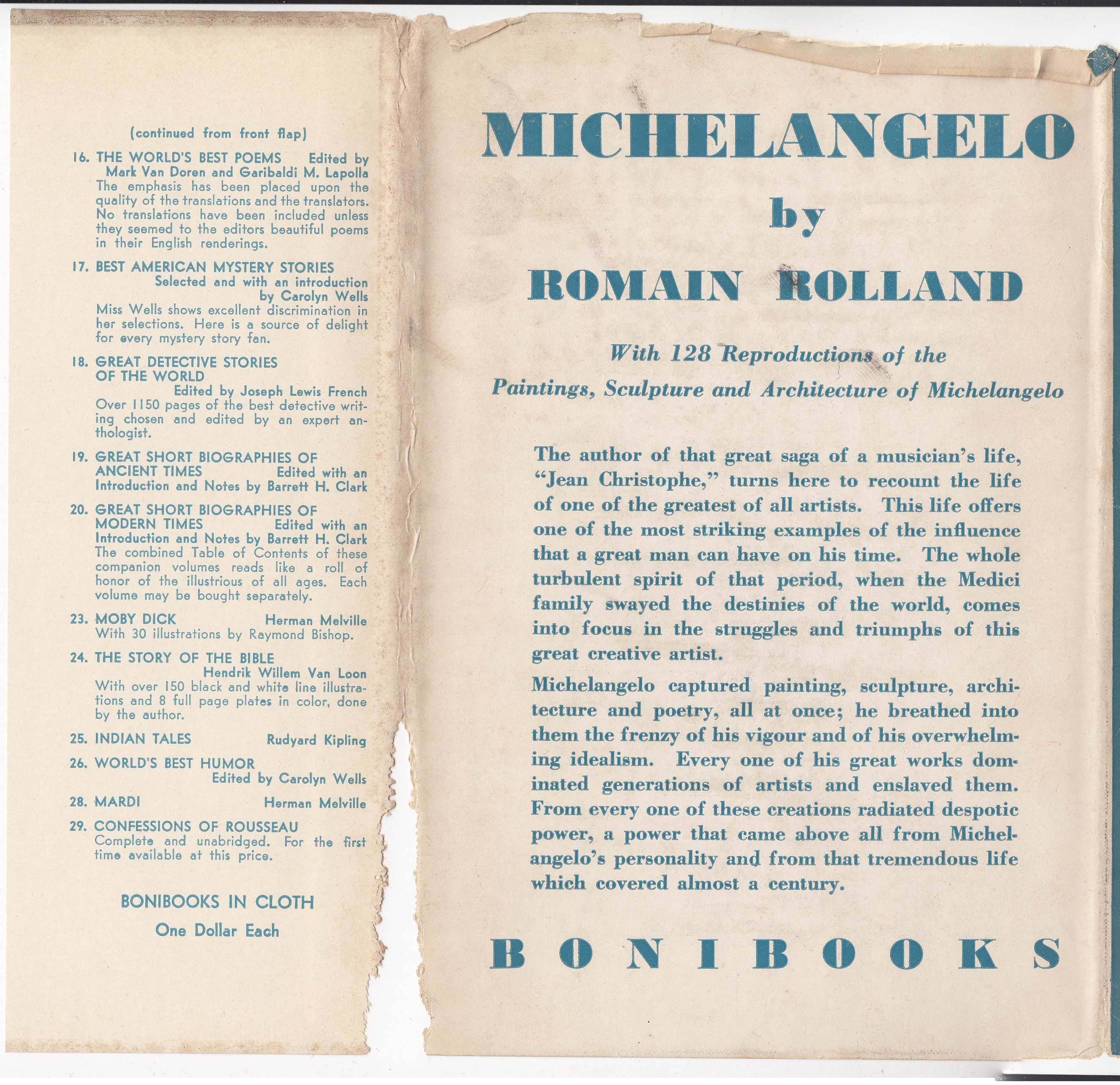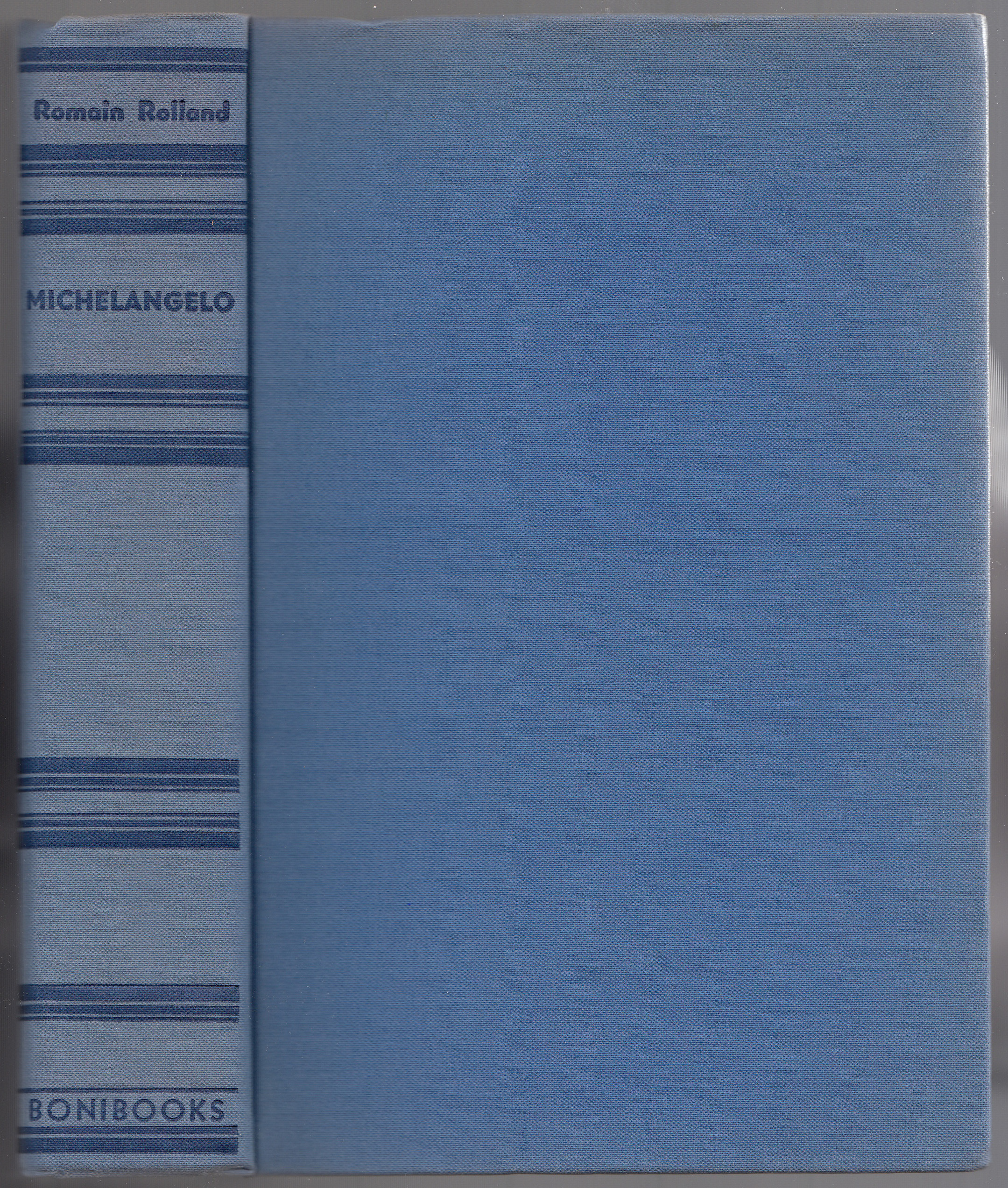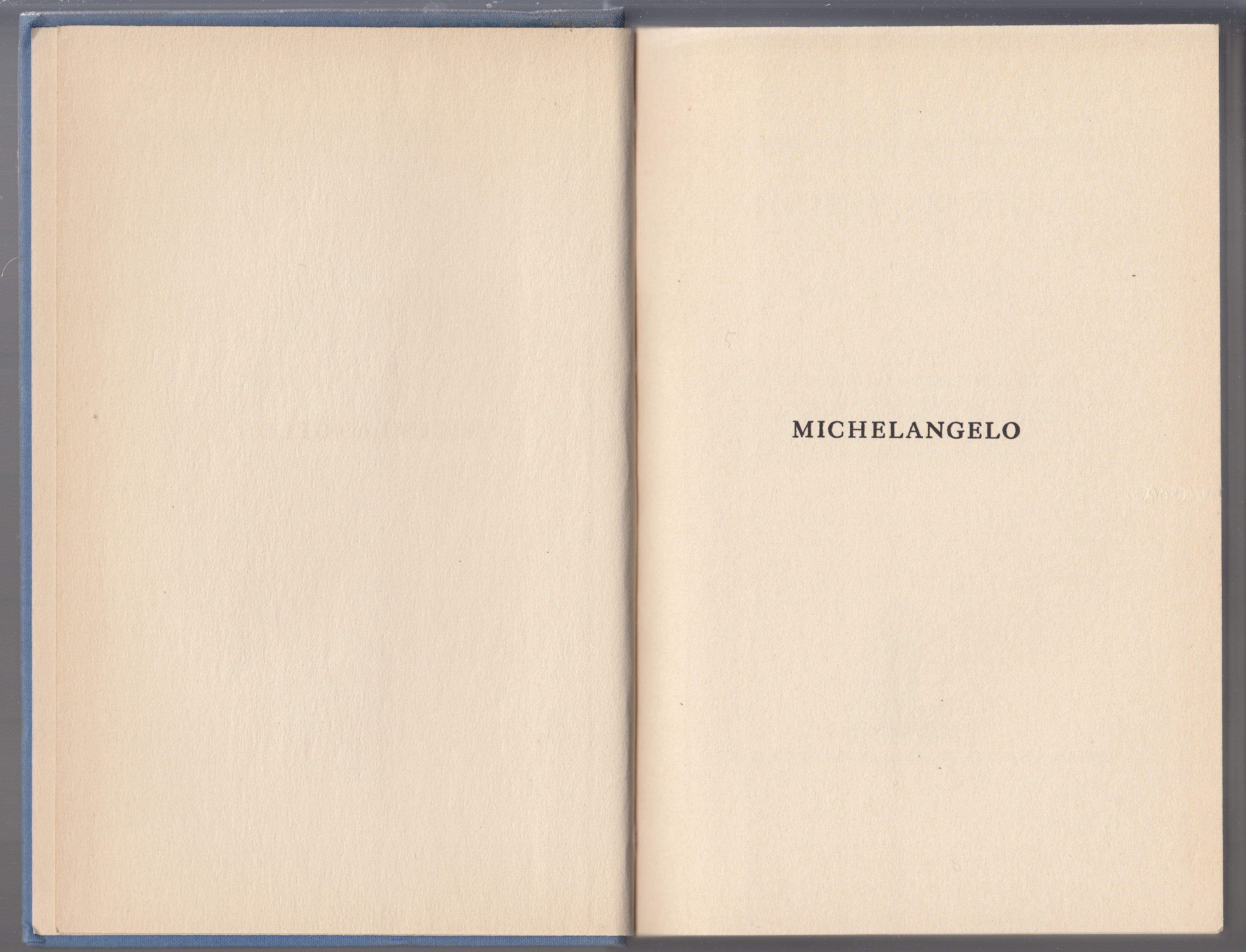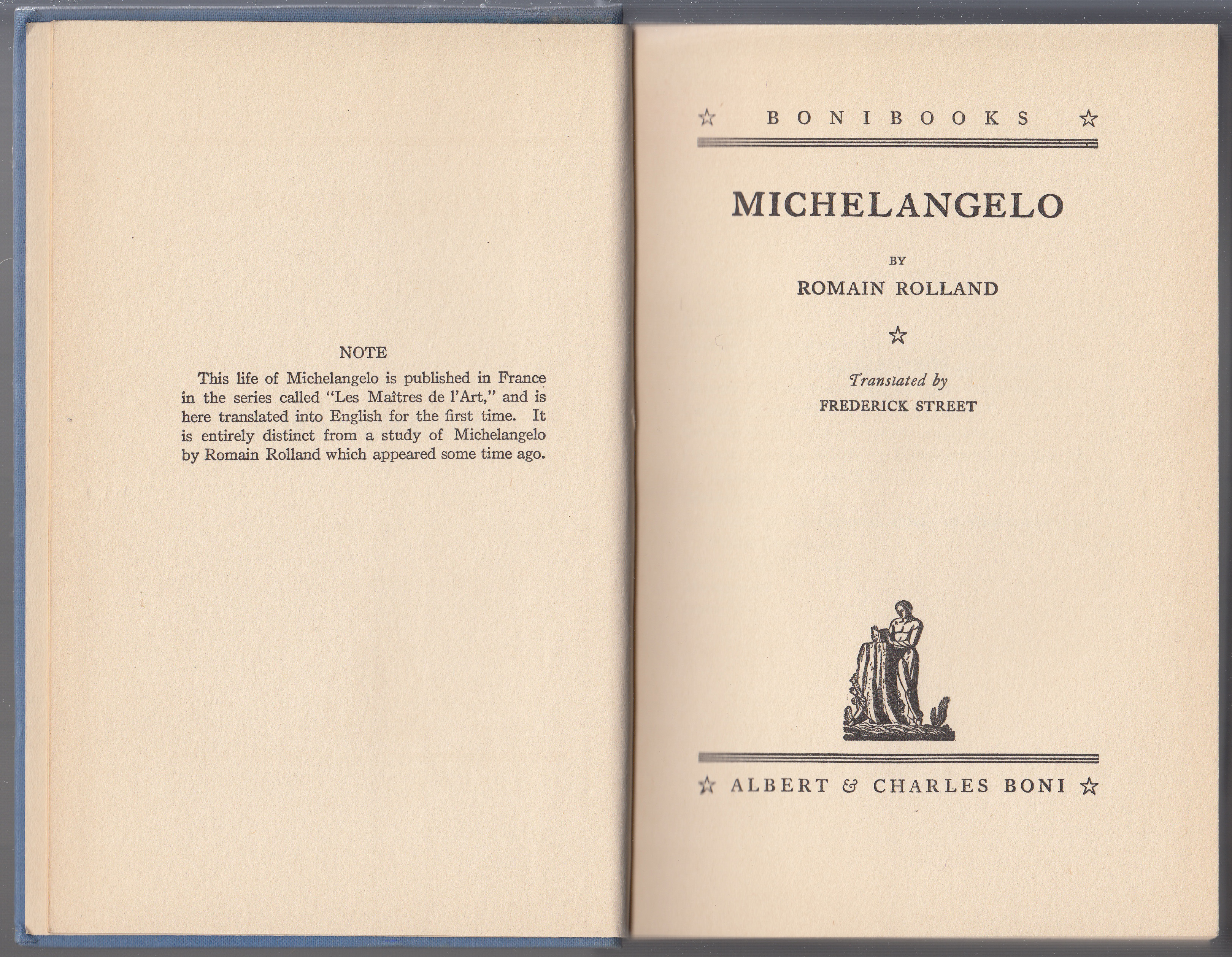aka/ Charles Boni Paper Books
Albert & Charles Boni (New York, US)
Series dates: 1929-1943
Size: 5″ x 7.5″ (paperbound), 5.75″ x 8.25″ (hardcover)
Updates: 8/8/2024
Publisher Albert and Charles Boni issued books with the Paper Books and Bonibooks series names between 1929 and 1943. A total of 16 Paper Books, 37 Bonibooks (original) series titles, and 49 or 51 Bonibooks (hardcover) series titles were issued, for 102 or 104 titles in the related series.
The initial series of newly published books in quality paperback format – the Charles Boni Paper Books – was a radical experiment: would buyers of modern literary writing go for a subscription-based series of paperback titles?
The book club model was controversial, at least among traditional publishers and booksellers. The Book of the Month Club (founded in 1926) and the subsequent book clubs it inspired were seen as a threat by the traditional book industry (given the book club’s low prices and sales via mail). The launch of Boni’s Paper Books club (in 1929) led Louis Brentano (vice president of Brentano’s bookstores and publishing) to discontinue carrying Boni publications at their stores. Boni was criticized for mimicking “questionable” book club practices such as offering a “free” book (which, of course, required you to become a paid member of the club and buy more books). The advertisements (see below) were criticized as hyperbolic and deceptive (Source: John Tebbel, A History of Book Publishing in the United States).
Paperbound books were also a treacherous commodity. Associated with cheap, low-grade fiction, paperbacks were not books to purchase and add to a personal library. Instead, paperbound books were typically purchased, read, and discarded (an exception was Tauchnitz Editions, but they were not sold in the US). Would purchasers of modern literary books go for quality paperbound books over more expensive hardbound titles? Boni’s competition at the time was series like the Modern Library (which offered a similar mix of literary fiction and non-fiction; the series was originally the creation of Boni & Liveright). The Modern Library was bound in flexible faux leather and balloon cloth (with jackets): a softer binding than traditional clothbound books, but not paperbound. In other words, the Modern Library editions still evoked characteristics of traditional hardbound books.
The Paper Books subscription titles arrived in a printed envelope. A copy of Darrell Figgis’ The Return of the Hero, one of the original Paper Books subscription series (issued on May 25, 1930), is shown below. It appears as if the address was added using a typewriter.
The book half-slid out of the envelope.
The book and the envelope.
The subscriber seems to be author and educator Joseph Mersand.
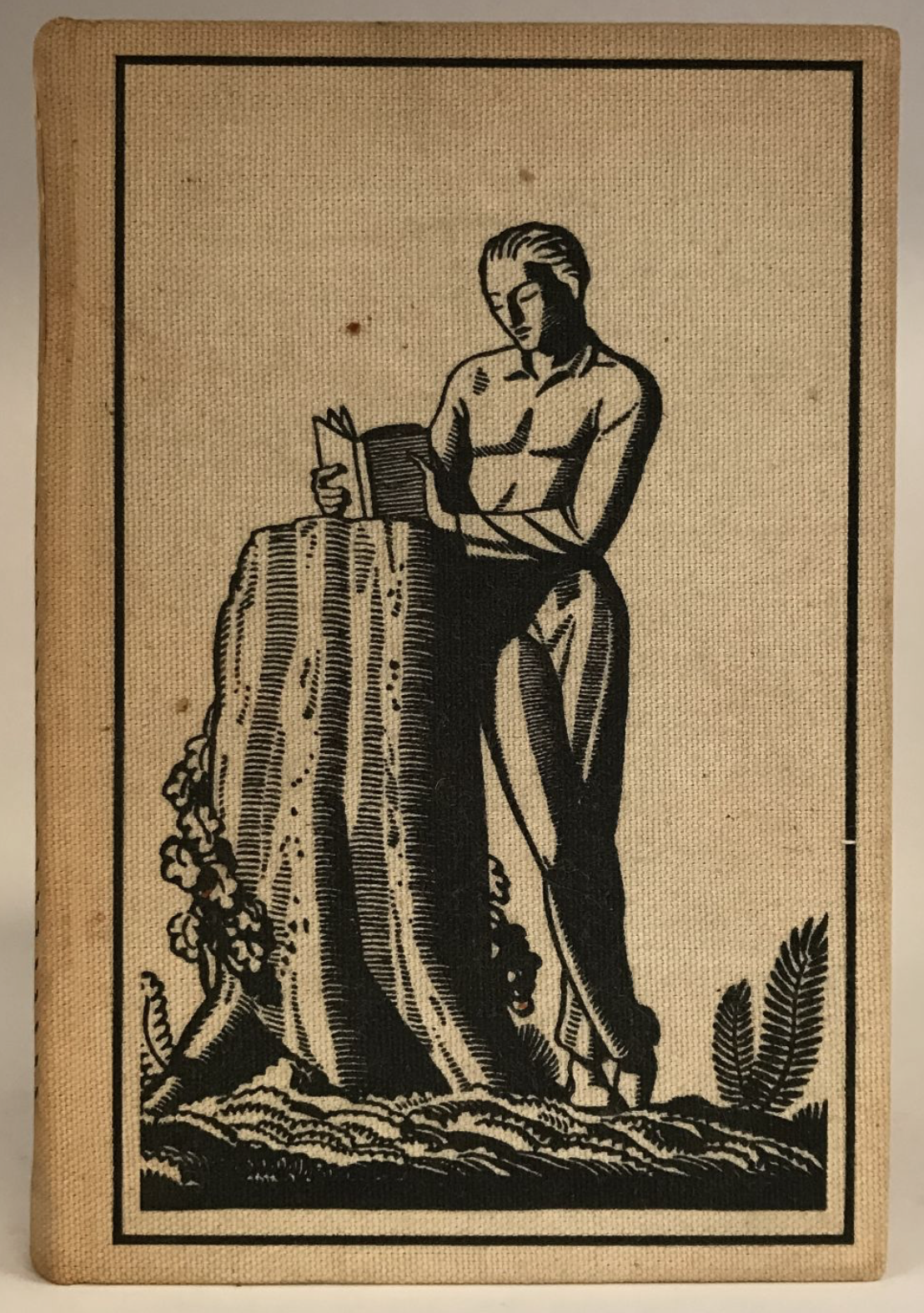
Paper Books titles could be returned to the publisher with $1 in exchange for a hardcover binding (or one could send $1.50, keep the paperback, and receive a hardcover copy of the title). Paper Books hardcovers from the Paper Book era were more-or-less custom bound and apparently issued without jackets. The cover design by Rockwell Kent (a man reading on a stump), which served as a colophon for the series, was printed on the hardbound covers. The policy soon changed: one could pay $1 for a hardcover of any book in the Paper Books series.
Boni seemed afraid that the quality paperback format would be too radical a departure for buyers of modern literature. The firm bent over backward to ensure that a hardcover was available.
Advertisements for the Paper Books club from May 25, 1929, to April 12, 1930:
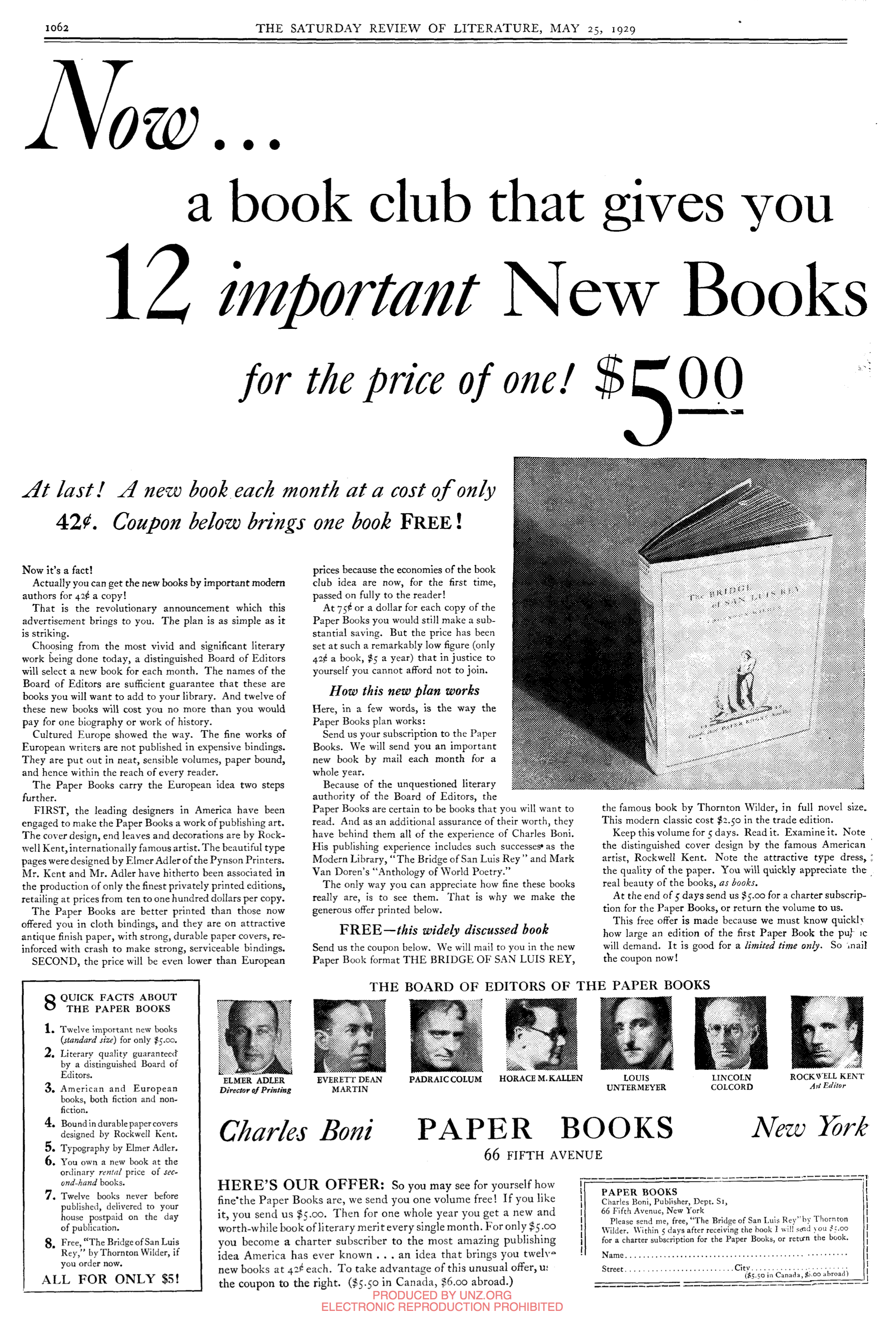



Boni’s experiment with the Paper Books failed by mid-1930, in part due to its launch at the start of the great depression. But the failure was also one of marketing (the emphasis on the book club vs. in-store sales) and buyers who were not quite ready for the next paperback revolution (there had been a surge in paperbound books in the latter half of the 1800s). The quality of the new titles in the series may have also played a role. By and large, Paper Books titles (in reviews) were seen as pleasant but forgettable.
The United States would have one more gallant, pre-WW2 effort to market the quality paperback by Modern Age Books (and their Red Seal, Blue Seal, and Gold Seal Books series) in 1937. The Modern Age Books effort also failed. Ultimately, a combination of growing openness to paperbacks by the American public and the use of the magazine distribution networks (with many more outlets for sales) propelled paperbacks to success in the years before (and after) WW2.
There are three distinct formats and groupings of books issued over the decade and a half the Paper Books / Bonibooks series was in print:
1929-1930: 16 titles issued as Charles Boni Paper Books Club (paperback) with a common jacket design on the first five titles (a wind-blown tree with books). Members of the club had an option to have their books rebound in hardcover. Rockwell Kent was the series designer. This was Boni’s initial groundbreaking experiment in subscription-based quality paperbacks. Titles, besides the initial (“free”) copy of Wilder’s The Bridge of San Luis Rey, were newly published books. The subscription was $5 / year, with a book to be delivered on the 25th of the month. Uniquely designed covers were used on titles issued in 1930 and afterward.
1930-1931: As the Paper Books struggled, Boni began issuing the reprint quality paperback (and hardcover) series BoniBooks. These titles were not part of the subscription book club. They were reprints of more popular, older Boni titles. While this series is in some ways separate from the Paper Books, it resembles the Paper Books in form and eventually absorbed many of the Paper Books titles. Thus I’ve combined the series on this page. 37 additional titles were issued as Bonibooks (paperback and hardcover) with unique jacket designs. Because the Bonibooks titles were reprints, the series contained better-known authors. There were reprints of most, but not all, of the original 16 Paper Books titles using the Bonibooks series name. By the end of the first Bonibooks era (1931), new paperbacks were being issued in printed slipcases. This suggests consumers were still struggling with the idea of the quality paperback. The slipcases would add some hardcover-like heft to series titles. Series advertising (below) had been reduced significantly after the demise of the Paper Books club.
1931-1936: By 1931, Boni had given up on the book club and the paperbound format altogether. The Bonibooks series continued with a new numbering scheme (and mostly new titles) but in hardcover only. A few earlier titles were reissued, sometimes using modified versions of the earlier jackets. Many new omnibus and edited collections were added to the series. The second coming of Bonibooks were utilitarian tomes, competing with the likes of the Modern Library Giants. A rather mundane and sad end to the experiment that began in 1929. The last reprint I can find is 1943.
Sources:
Christopher P. Stephens, A Checklist of the BoniBooks and the Boni Paper Books (Ultramarine, 1994)
Charles Boni Paper Books (The Consecrated Eminence)
Boni Paper Books, part I, part II, part III, by Josh MacPhee (Just Seeds)
Charles A. Wagner’s edited collection Prize Poems 1913 – 1929 was issued as the 9th title in the Boni Paper Books subscription service on April 25, 1930. It was later reissued as #20 in the Bonibooks series. This copy sports the hardcover binding, which was available to subscribers. There is no way of knowing if this was a title returned by its owner (with $1) for rebinding in cloth or was purchased as a hardcover for $1 (as compared to .50 cents for the paperbound version). The front cover of the book includes the Rockwell Kent illustration printed in black. The spine has a plant design with the publisher. The title is printed on paper and glued to the spine. Multiple sources indicate that these titles were issued without jackets (they were, in essence, not sold in stores but available by special order and did not need the protection or advertising a jacket offered).
The book is identical to the paperbound titles after the cover. The endpapers are another Kent design used on the front of the first five Boni Paper Books. The owner dated the book in 1933, three years after it was issued.
The half-title page:
The title page repeats the Kent illustration that served as the Paper Books / Bonibooks colophon. The date (1930) surrounds the colophon.
The copyright page:
The last two pages are a prospectus for the series:
| DATE FOR FORMAT SEPT 25 OCT 25 NOV 25 DEC 26 JAN 25 FEB 25 MAR 25 APR 25 |
TITLE The Bridge of San Luis Rey The Golden Wind Frederick the Great Dewer Rides Prosperity: Fact or Myth Commando My Reminiscences as a Cowboy The Master of the Day of Judgment Prize Poems, 1913-1929 |
AUTHOR Thornton Wilder Takashi Ohta & M. Sperry
Margaret Goldsmith |
“ROCKWELL KENT has designed a cloth binding. Subscribers wishing copies bound can send them to us with the following charges: $1.00 for one copy, and 50 cents for each additional copy sent at the same time. Be sure to enclose your name and address printed plainly in each package. Subscribers can buy bound copies without returning their paper edition for $1. 50 for one copy, and $1.00 for each additional one, sent to one address at the same time.”
“PAPER BOOKS are mailed to all subscribers on the 25th of each month.”
“NOTICE OF CHANGE OF ADDRESS should include the old address as well as the new, and be printed plainly to obviate error. We must have notice at least six weeks before it can be effected.”
“Subscription prices for PAPER BOOKS: one year, for Continental United States of America $5.00; elsewhere $6.00”
The book below is a 1931 copy of H.E. Raabe’s Cannibal Nights, the 48th book published in the series, but (due to a few deleted titles) officially #44 in Boni’s series numbering. The book was originally published in 1927. This title was the first to be issued with the printed slipcase. The next five Bonibooks titles issued came in slipcases. Reprints of earlier titles were also issued in a slipcase. Every side of the slipcase was printed: the top of the slipcase is shown below:
The Paper Books and Bonibooks were known for their striking cover artwork, inspired by Rockwell Kent’s involvement in the series design. The artwork for Cannibal Nights by illustrator and artist Edward Staloff is certainly distinctive. The series name is included on the front of the slipcase and the spine (as “Boni Books”). The back of the slipcase, with the Rockwell Kent series illustration (colophon), describes the book, then lists the Bonibooks titles (up through The Case of Jenny Brice). Three more titles would be added to this list. Notice an indentation (upper right) so the book can be easily pulled from the slipcase.
The slipcase spine, back, and front:
 |
 |
The bottom of the slipcase repeats the series name:
The spine of the book in the slipcase:
The front and the back paper cover of the book repeat the design from the slipcase (the artwork is reflected, but the typography remains the same). Notice that the series name on the bottom of the cover is cut off. The artwork was sized for the slipcase, and the books were cut down slightly to fit in the slipcase (thus cutting into the series name). The Bonibooks logo at the bottom of the cover (slipcase and book) was adjusted on other copies to avoid this problem.
Blue paper endpapers:
The half-title page:
An illustration from the book faces the title page. The title page includes a Rockwell Kent illustration of a man reading a book on a tree stump. The date (1931) is incorporated into this illustration. Earlier titles often include either “Paper Books” or “Bonibooks” on the title page.
The copyright date is 1927, to publisher Payson & Clark, Ltd.
A catalog of titles in the series is included on the last pages of the book.
The catalog matches the titles on the slipcover:
Below are the 53 Paper Books and Bonibooks (original) series in order of publication. For books initially issued as part of the Paper Books, the month and date of publication are included. The first number is the one assigned in the Stephens bibliography below. This is the master, numbered list of all titles published in the Paper Books and Bonibooks series.
#29-#32 of the Paper Books are preceded by 16 Bonibooks titles. This resulted from starting the Bonibooks series while finishing the Paper Books subscription plan. The second set of numbers was assigned by Boni when the Bonibooks replaced the Paper Books in 1930. These are the series numbers that appear in the catalogs of Bonibooks titles (in the books and on the slipcases if issued). (#–) means that the title was not included in the later renumbered series: in other words, deleted titles.
I’ve updated the list below with additional titles reissued in the slipcase (marked by ***).
Source: Christopher P. Stephens, A Checklist of the BoniBooks and the Boni Paper Books (Ultramarine, 1994).
1929
* **(#1) (#–) The Bridge of San Luis Rey, Thornton Wilder (May 1929)
* **(#2) (#23) The Golden Wind, Takashi Ohta and Margaret Sperry (September 25, 1929)
* **(#3) (#24) Frederick the Great, Margaret Goldsmith (October 25, 1929)
* **(#4) (#25) Dewer Rides, L.A.G. Strong (November 25, 1929)
* **(#5) (#15) Prosperity, Fact or Myth, Stuart Chase (December 26, 1929)
Above: Against the Grain, J.K. Huysmans (#26, #14). One of at least four 1930 titles reissued in a sleeve (marked ***).
1930
*(#6) (#16) Commando: A Boer Journal of the Boer War, Deneys Reitz (January 25, 1930)
*(#7) (#17) My Reminiscences as a Cowboy, Frank Harris (February 25, 1930)
*(#8) (#18) The Master of the Day of Judgment, Leo Perutz (March 25, 1930)
* ***(#9) (#20) Prize Poems 1913-1929, Edited by Charles Wagner (April 25, 1930)
*(#10) (#19) The Return of the Hero, Darrell Figgis (May 25, 1930)
*(#11) (#26) By the Waters of Manhattan, Charles Reznikoff (June 25, 1930)
*(#12) (#27) All in the Racket, William E. Weeks (July 25, 1930)
(#13) (#1) The History of Mr. Polly, H.G. Wells
(#14) (#2) Tar, Sherwood Anderson (July 1930)
(#15) (#3) Israel, Ludwig Lewisohn
***(#16) (#4) Michelangelo, Romain Rolland (July 1930)
***(#17) (#5) The Lost Girl, D.H. Lawrence
(#18) (#6) The Personal Relation in Industry, John D. Rockefeller, Jr.
(#19) (#7) The Hard-Boiled Virgin, Frances Newman
(#20) (#8) Moby Dick; or, The Whale, Herman Melville (1931?)
(#21) (#9) Open All Night, Paul Morand
(#22) (#10) Cheri, Colette
(#23) (#11) Our Changing Morality, Frida Kirchwey, Bertrand Russell
(#24) (#12) What Is Wrong with Marriage? Gilbert Hamilton and Kenneth MacGowan
(#25) (#13) Kept, Alec Waugh
***(#26) (#14) Against the Grain, J.K. Huysmans
(#27) (#21) Our Business Civilization, James Truslow Adams
(#28) (#22) The Cardinal’s Mistress, Benito Mussolini
*(#29) (#28) Margaret Fuller: A Biography, Margaret Bell (August 25, 1930)
*(#30) (#–) Wandering Women, John Cournos (September 25, 1930)
*(#31) (#–) Sun-Way, Margaret Sperry (October 25, 1930)
*(#32) (#–) Crime and Destiny, Joannes Lance (November 25, 1930)
(#33) (#29) My University Days, Maxim Gorky
(#34) (#30) This Earth of Ours, Jean-Henri Fabre
(#35) (#31) Wonder Book of Chemistry, Jean-Henri Fabre
(#36) (#32) Why Men Fight, Bertrand Russell
(#37) (#33) The Story of the Irish Nation, Francis Hackett
***(#38) (#34) The Captain’s Doll, D.H. Lawrence
(#39) (#35) Madame Bovary, Gustave Flaubert
(#40) (#36) Salammbo, Gustave Flaubert
(#41) (#37) Intentions, Oscar Wilde
(#42) (#38) Letters from the Raven, Lafcadio Hearn
(#43) (#39) Batouala, Rene Maran
Above: The Case of Jennie Brice, Mary Roberts Rinehart (#50, #46). One of six new 1931 titles issued only in a slipcase.
Above: a reissue of The Autobiography of Benvenuto Cellini (#47, #43) in a slipcase.
Above: a copy of D.H. Lawrence’s Captain’s Doll (#38, #34) in a slipcase.
1931
***(#44) (#40) The High Place, James Branch Cabell (1931)
(#45) (#41) Thais, Anatole France (1931)
***(#46) (#42) The Way of All Flesh, Samuel Butler (1931)
***(#47) (#43) The Autobiography of Benvenuto Cellini, Cellini (1931)
****(#48) (#44) Cannibal Nights, H.E. Raabe (paperback in slipcase) (1931)
****(#49) (#45) Brooklyn Murders, G.D.H. Cole (paperback in slipcase) (1931)
****(#50) (#46) The Case of Jennie Brice, Mary Roberts Rinehart (paperback in slipcase) (1931)
****(#51) (#47) The Port of Missing Men, Meredith Nicholson (paperback in slipcase) (1931)
****(#52) (#48) South Wind, Norman Douglas (paperback in slipcase) (1931)
****(#53) (#49) The Ponson Case, Freeman Wills Crofts (paperback in slipcase) (1931)
*originally issued as Charles Boni Paper Books as part of the subscription plan
**original title issued with common tree design cover
***paperback reprints issued in a slipcase
****all paperbacks issued in a slipcase
Above: The Ponson Case, Freeman Wills Crofts (#53, #49). The last title issued in the Bonibooks paperback series. This title originally came with a slipcase (missing here).
The Bonibooks series also failed to gain traction in the market. In 1931, Boni issued the third iteration of the Paper Books / Bonibooks series with hardcover-only titles in a larger format, using the Bonibooks name. Some titles from the earlier series were included, but many were reprints of edited books or omnibus editions. The book and jacket design were typically mundane compared to the earlier paperbound titles.
This copy of Romain Rolland’s Michelangelo is #12 in this series version and has a 1935 publication date. The title was originally added to the paperbound Bonibooks series in July 1930. The jacket is unique to the title and a variation of the jacket design used on the July 1930 paperback issue. The name Bonibooks is included on the jacket spine but not on the front of the book. The front jacket flap lists the “Bonibooks in Cloth” priced at $1:
“It is the purpose of the publishers to include in this series only books of solid and enduring value, by authors who have some valid claim to permanence, if not greatness; they hope to make the Bonibooks imprint synonymous with literary and intrinsic excellence. New titles are being constantly added. The following titles are now available:”
… and the list of 29 titles begins, ending on the rear jacket flap. The list is reproduced further below.
The rear jacket flap (and catalog of Bonibooks hardcover titles). The back of the jacket advertises the book itself.
$1.00
BONIBOOKS IN CLOTH
One Dollar Each
It is the purpose of the publishers to include in this series only books of solid and enduring value, by authors who have some valid claim to permanence, if not greatness; they hope to make the Bonibooks imprint synonymous with literary and intrinsic excellence. New titles are being constantly added. The following titles are now available:
1. American Oxford Dictionary, Compiled by F.G. and H.W. Fowler
2. Education and the Good Life, Bertrand Russell
3. Great Short Stories Of The World, Edited by Clark and Lieber. The book contains one hundred and seventy-seven short stories, by as many authors, covering five thousand years and thirty-five different literatures.
4. Oxford Book of American Verse, Edited by Bliss Carman. A complete survey of American verse from the beginnings to the present, from Stephen Collins Foster to Edna St. Vincent Millay.
6. This Earth Of Ours, Jean-Henri Fabre
7. Against the Grain, J.K. Huysmans
8. Our Business Civilization, James Truslow Adams
9. The High Place, James Branch Cabell
10. What Is Wrong With Marriage, Hamilton and MacGowan …frank and intimate testimony on marriage from normal men and women examined under controlled scientific conditions.
11. South Wind, Norman Douglas
12. Michelangelo, Romain Rolland
13. The History Of Mr. Polly, H.G. Wells
The finest example of the writing of H.G. Wells.
14. Tar: A Midwest Childhood, Sherwood Anderson
15. The World’s Best Essays, From Confucius to Mencken, Edited by F.H. Pritchard
A complete survey of the progress of human thought throughout the ages as represented by the essay. This dollar edition is reprinted absolutely unabridged from the plates of the original edition, published over 2 years ago, and the reduction in price is now made possible by their use.
16. The World’s Best Poems, Edited by Mark Van Doren and Garibaldi M. La Polla
The emphasis has been placed upon the quality of the translations and the translators. No translations have been included unless they seemed to the editors beautiful poems in their English renderings.
17. Best American Mystery Stories, Selected and with an introduction by Carolyn Well. Miss Wells shows excellent discrimination in her selections. Here is a source of delight for every mystery story fan.
18. Great Detective Stories of The World, Edited by Joseph Lewis French
Over 1150 pages of the best detective writing chosen and edited by an expert anthologist.
19. Great Short Biographies of Ancient Times, Edited with an Introduction and Notes by Barrett H. Clark
20. Great Short Biographies of Modern Times, Edited with an Introduction and Notes by Barrett H. Clark. The combined Table of Contents of these companion volumes reads like a roll of honor of the illustrious of all ages. Each volume may be bought separately.
23. Moby Dick, Herman Melville
With 30 illustrations by Reymond Bishop.
24. The Story Of The Bible, Hendrik Willem Van Loon. With over 150 black and white line illustrations and 8 full-page plates in color, done by the author.
25. Indian Tales, Rudyard Kipling
26. World’s Best Humor, Edited by Carolyn Wells
28. Mardi, Herman Melville
29. Confessions Of Rousseau. Complete and unabridged. For the first time available at this price.
BONIBOOKS IN CLOTH
One Dollar Each
I do not have the numbering for titles added to the series after Michelangelo. The list below includes 15 titles issued in 1935 and 5 titles issued in 1936. Renan’s The Life of Jesus (with a 1936 date) is listed as series #51 for one copy in WorldCat. If this is correct, there are two missing Bonibooks titles in these lists (which include 49 titles). They might be variations on the Wilde titles.
Bonibooks: 1935 (15 titles)
The Civilization of the Renaissance in Italy, Jacob Burckhardt; translated by S.G.C. Middlemore
The Essays of Oscar Wilde, Oscar Wilde
The Devil’s Dictionary, Ambrose Bierce
Letters of a Self-made Diplomat to his President, Will Rogers, illustrated by Herbert Johnson
Towards Democracy, Edward Carpenter
An Anthology of Friendship, Edward Carpenter
The Prose of Oscar Wilde, Oscar Wilde
The Poems of Oscar Wilde, Oscar Wilde
The Plays of Oscar Wilde, Oscar Wilde
Best American Humor of Today, June Barrows Mussey
… Told at the Explorers Club; True Tales of Modern Exploration, F.A. Blossom
The Novels and Fairy Tales of Oscar Wilde, Oscar Wilde
Adventures of an African Slaver, Theodore Canot; edited by Brantz Mayer
Great Short Biographies of Ancient Times, the Middle Ages and the Renaissance, Barrett H. Clark
The Man Shakespeare and His Tragic Life-Story, Frank Harris
Bonibooks: 1935 (5 titles)
The Brass Check, Upton Sinclair (1936)
The Goose-Step, Upton Sinclair (1936)
The Bridge of San Luis Rey, Thornton Wilder (1936)
The Illiterate Digest, Will Rogers (1936)
51. The Life of Jesus, by Ernest Renan (1936)
Basic blue cloth bindings with blue printed typography and graphics on the spine. The series name is at the base of the spine. The book cover is blank.
The half-title page:
The title page:
The copyright page:




